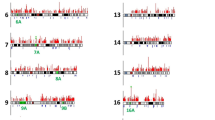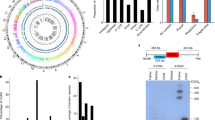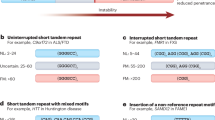Abstract
Expansions of trinucleotide repeats within gene transcripts are responsible for fragile X syndrome, myotonic dystrophy and spinal and bulbar muscular atrophy. To identify other human genes with similar features as candidates for triplet repeat expansion mutations, we screened human cDNA libraries with repeat probes and searched databases for transcribed genes with repeats. From both strategies, 40 genes were identified and 14 characterized. Five were found to contain repeats which are highly polymorphic including the N–cadherin, BCR, glutathione–S–transferase and Na+/K+ ATPase (β–subunit) genes. These data demonstrate the occurrence of other human loci which may undergo this novel mechanism of mutagenesis giving rise to genetic disease.
This is a preview of subscription content, access via your institution
Access options
Subscribe to this journal
Receive 12 print issues and online access
$209.00 per year
only $17.42 per issue
Buy this article
- Purchase on Springer Link
- Instant access to full article PDF
Prices may be subject to local taxes which are calculated during checkout
Similar content being viewed by others
References
Fu, Y.H. et al. Variation of the CGG repeat at the fragile X site results in genetic instability: resolution of the Sherman paradox. Cell 67, 1047–1058 (1991).
Verkerk, A.J. et al. Identification of a gene (FMR-1) containing a CGG repeat coincident with a breakpoint cluster region exhibiting length variation in fragile X syndrome. Cell 65, 905–914 (1991).
Kremer, E.J. et al. Mapping of DNA instability at the fragile X to a trinucleotide repeat sequence p(CCG)n. Science 252, 1711–1714 (1991).
Vincent, A. et al. Abnormal pattern detected in fragile-X patients by pulsed-field gel electrophoresis. Nature 349, 624–626 (1991).
Oberle, I. et al. Instability of a 550-base pair DNA segment and abnormal methylation in fragile X syndrome. Science 252, 1097–1102 (1991).
Yu, S. et al. Fragile X genotype characterized by an unstable region of DNA. Science 24, 1179–1181 (1991).
Pieretti, M. et al. Absence of expression of the FMR-1 gene in fragile X syndrome. Cell 66, 817–822 (1991).
Bell, M.V. et al. Physical mapping across the Fragile X: Hypermethylation and clinical expresion of the fragile X syndrome. Cell 64, 861–866 (1991).
Sutcliffe, J.S. et al. DNA methylation represses FMR-1 transcription in fragile X syndrome. Hum. molec. Gen. (in the press).
Sherman, S.L. et al. The marker(X) syndrome: A cytogenetic and genetic analysis. Ann. hum. Genet. 48, 21–37 (1984).
Sherman, S.L. et al. Further segregation analysis of the fragile X syndrome with special reference to transmitting males. Hum. Genet. 69, 289–299 (1985).
Harper, P.S., Harley, H.G., Reardon, W. & Shaw, D.J. Review article: Anticipation in myotonic dystrophy: New light on an old problem. Am. J. hum. Genet. 51, 10–16 (1992).
Brook, J.D. et al. Molecular basis of myotonic dystrophy: expansion of a trinucleotide (CTG) repeat at the 3′ end of a transcript encoding a protein kinase family member. Cell 68, 799–808 (1992).
Fu, Y.H. et al. An unstable triplet repeat in a gene related to myotonic muscular dystrophy. Science 255, 1256–1258 (1992).
Mahadevan, M. et al. Myotonic dystrophy mutation: an unstable CTG repeat in the 3′ untranslated region of the gene. Science 255, 1253–1255 (1992).
Harley, H.G. et al. Unstable DNA sequence in myotonic dystrophy. Lancet 339, 1125–1128 (1992).
La Spada, A.R. et al. Androgen receptor gene mutations in X-linked spinal and bulbar muscular atrophy. Nature 352, 77–79 (1991).
Biancalana, V. et al. Moderate instability of the trinucleotide repeat in spino bulbar muscular atrophy. Hum. molec. Gen. 1, 255–258 (1992).
La Spada, A.R. et al. Meitotic stability and genotype-phenotype correlation of the expanded trinucleotide repeat sequence in X-linked spinal and bulbar muscular dystrophy. Nature Genet. (in the press).
Miyake, S., Emori, Y. & Suzuki, K. Gene organization of the small subunit of human calcium-activated neutral protease. Nucl. Acids Res. 14, 8805–8817 (1986).
Galjart, N.J. et al. Expression of cDNA encoding the human ‘protective protein’ associated with lysomsomal beta-galactosidase and neuraminidase: Homology to yeast proteases. Cell 54, 755–764 (1988).
Polymeropoulos, M.H., Rath, D.S., Xiao, H. & Merril, C.R. Trinucleotide repeat polymorphism at the human transcription factor IID gene. Nucl. Acids Res. 19, 4307 (1991).
Gonzalez, I.L. et al. Variation among human 28S ribosomal RNA genes. Proc. natn. Acad. Sci. U.S.A. 82, 7666–7670 (1985).
Strisciuglio, P. et al. The presence of a reduced amount of 32-kd “protective” protein is a distinct biochemical finding in late infantile galactosialidosis. Hum. Genet. 80, 304–306 (1988).
Zhou, X.Y. et al. A mutation in a mild form of galactosialidosis impairs dimerization of the protective protein and renders it unstable. EMBO J. 10, 4041–4048 (1991).
Nanba, E., Tsuji, A., Omura, K. & Suzuki, Y. Galactosialidosis: molecular heterogeneity in biosynthesis and processing of protective protein for beta-galactosidase. Hum. Genet. 80, 329–332 (1988).
Sutherland, G.R. & Ledbetter, D.H. Report of the committee on cytogenetic markers. Cytogenet. Cell Genet. 51, 452–548 (1992).
Richarrds, R.I. et al. Evidence of founder chromosomes in fragile X syndrome. Nature Genet. 1, 257–260 (1992).
Harley, H.G. et al. Detection of linkage disequilibrium between the myotonic dystrophy locus and a new ploymorphic DNA marker. Am. J. hum. Genet. 49, 68–75 (1991).
Nowell, P.C. & Hungerford, D.A. A minute chromosome in human chronic granulocytic leukemia. Science 132, 1497 (1960).
Mir, M.A. et al. Sodium-potassium-ATPase and obesity. New Engl. J. Med. 310, 528–529 (1984).
Beutler, E., Kuhl, W. & Sacks, P. Sodium-potassium-ATPase activity is influenced by ethnic origin and not by obesity. New. Engl. J. Med. 309, 756–760 (1983).
Mir, M.A., Charalambous, B.M., Morgan, K. & Evans, P.J. Erythrocyte sodium-potassium-ATPase and sodium transport in obesity. New Engl. J. Med. 305, 1264–1268 (1981).
McDonough, A.A., Geering, K. & Farley, R.A. The sodium pump needs its β subunit. FASEB J. 4, 1598–1605 (1990).
Idle, J.R. Is environmental carcinogenesis modulated by host polymorphism? Mutat Res. 247, 259–266 (1991).
Strange, R.C. et al. The human glutathione S-transferases: a case-control study of the incidence of the GST1 0 phenotype in patients with adenocarcinoma. Carcinogenesis 12, 25–28 (1991).
Sambrook, J., Fritsch, E.F. & Maniatis, T. Molecular cloning: a laboratory manual, 2 edn (Cold Spring Harbor Laboratory Press, New York, 1989).
Botstein, D., White, R.L., Skolnick, M. & Davis, R.W. Construction of a genetic linkage map in man using restriciton fragment length polymorphisms. Am. J. hum. Genet. 32, 314–331 (1980).
Shah, N.P., Witte, O.N. & Denny, C.T. Characterization of the BCR promoter in Philadelphia chromosme-positive and -negative cell lines. Molec. cell Biol. 11, 1854–1860 (1991).
Hoshino, S. et al. A human homologue of the yeast GST1 gene codes for a GTP-binding protein and is expressed in a proliferation-dependent manner in mammalian cells. EMBO J. 8, 3807–3814 (1989).
Reid, R.A. & Hemperly, J.J. Human N-cadherin nucleotide and deduced amino acid sequence. Nucl. Acids Res. 18, 5896 (1990).
Lane, L.K., Shull, M.M., Whitmer, K.R. & Lingrel, J.B. Characterization of two genes for the human Na, K-ATPase beta subunit. Genomics 5, 445–453 (1990).
Miyajima, N. et al. Identification of two novel members of erbA superfamily by molecular cloning: the gene products of the two are highly related to each other. Nucl. Acids Res. 16, 11057–11074 (1988).
Zhu, Q.S., Heisterkamp, N. & Groffen, J. Unique organization of the human BCR gene promoter. Nucl. Acids Res. 18, 7119–7125 (1990).
McKusick, V.A. Genetic Maps (Cold Spring Harbor Laboratory Press, New York, 1992).
Walsh, F.S. et al. N-cadherin gene maps to human chromosome 18 and is not linked to the E-cadherin gene. J. Neurochem. 55, 805–812 (1990).
Lane, L.K., Shull, M.M., Whitmer, K.R. & Lingrel, J.B. Characterization of two genes for the human Na, K-ATPase beta subunit. Genomics. 5, 445–453 (1989).
Yang Feng, T.L. et al. Chromosomal localization of human Na+, K+-ATPase alpha- and beta-subunit genes. Genomics 2, 128–138 (1988).
Ohno, S. et al. Four genes for the calpain family locate on four distinct human chromosomes. Cytogenet. Cell Genet. 53, 225–229 (1990).
Wiegant, J., Galjart, N.J., Raap, A.K. & d'Azzo, A. The gene encoding human protective protein (PPGB) is on chromosome 20. Genomics 10, 345–349 (1991).
Author information
Authors and Affiliations
Rights and permissions
About this article
Cite this article
Riggins, G., Lokey, L., Chastain, J. et al. Human genes containing polymorphic trinucleotide repeats. Nat Genet 2, 186–191 (1992). https://doi.org/10.1038/ng1192-186
Received:
Accepted:
Issue Date:
DOI: https://doi.org/10.1038/ng1192-186



